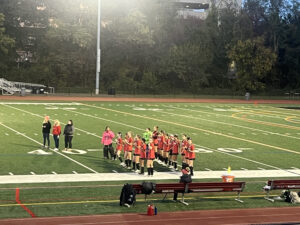
A little-known book of all-but-forgotten folk music is brought to life by two members of a country-rock band. Professional musicians throw open the doors of a church in small-town Pennsylvania and invite locals to listen, and even play along. An 8-year-old fiddle prodigy is discovered.
It’s no wonder David Bielanko says the story of making Marah Presents Mountain Minstrelsy of Pennsylvania “eclipses the record on every level.”
The recording project, spearheaded by Bielanko and Marah bandmate Christine Smith, began with a book. They received Mountain Minstrelsy of Pennsylvania as a gift. The 1931 compilation by folklorist Henry W. Shoemaker documents the bare bones of songs that had been passed down through generations and recalled for him. The two musicians had just moved from New York City to the middle of Pennsylvania, and they were taken with the book and its songs.
“Those songs for the most part are completely gone. Nobody plays them, and no one knows how they go. But they still existed, on this strange level, in this book,” Bielanko says. “The idea of trying to see what they’re made of and just prop them up and take their picture one more time before they vanished altogether seemed really intriguing.”
Take “Luliana.” The song, Shoemaker reports, was recalled by Daniel Elliott, born in 1853, the son of a Civil War soldier who died in a Confederate prison. Elliott said he learned it from his grandmother. Bielanko had lyrics there, but those words didn’t have an intrinsic musical quality. The piece needed a strong melody, Bielanko says. They interpreted it as a waltz, made a few tweaks to the lyrics, and had their song. Other songs required a heavier hand.
“With as much respect toward the past and tradition as we could possibly muster, we took every liberty in the world,” Bielanko says. There was an inherent imperfection to the book in its reliance on recollection, and thus in the recording project they could take the ghosts of songs and imagine what they once were and what they should be. And they were, after all, making their own music. They were going to add rock and roll to the mix.
In the book they had the outlines of songs, but they were also working with the outlines of a band. Bielanko and Smith had to find musicians locally who could easily meet up to record. An old church in Millheim, Pennsylvania, became their recording studio. The borough has a population of less than 1,000, but they found the talent they needed. Area musicians James Baughman, Chris Rattie, and Kai Schafft were enlisted to play on the album. The recording sessions were open, inviting residents to stop in; scores of locals were singing along with the group on “Ten Cents at the Gate.”
And then there’s Gus.
In talking to locals about finding the right fiddle player, the name Gus Tritsch came up. He’s 10 now, but at the time he was 8 years old. Smith and Bielanko asked Gus’ parents if he could play on the album. They got the OK, his parents bought the book, and soon Gus was ready to make a record with the professional musicians. When he played, Bielanko says, jaws dropped; he had an inexplicable grasp on folk music and fiddle playing even at his young age.
Marah Presents Mountain Minstrelsy of Pennsylvania, released last week, was originally intended as a recorded side project but the group has booked a handful of gigs to bring Mountain Minstrelsy to the stage, played by the band that recorded it – Gus included.
Next Thursday, March 13, at Jammin’ Java, concert-goers can hear the songs that were nearly lost played by the musicians who revived them, and become part of the incredible story that was written in the process.
“It’s a folk show, and it has a big heart and it has a big story,” Bielanko says. “I believe people need a story. Not in a marketing sense, but in a sense that it’s all we’re really good at as human beings.”
• For more information about Marah, visit marah-usa.com.












